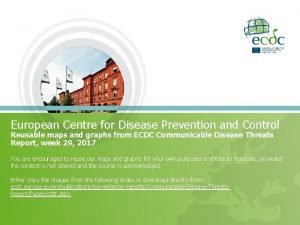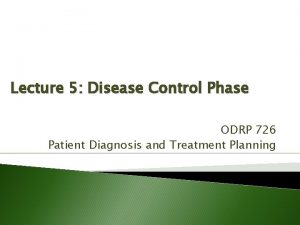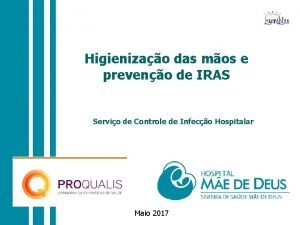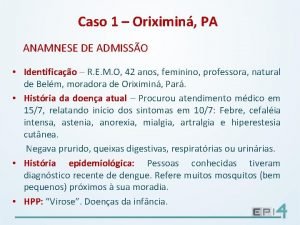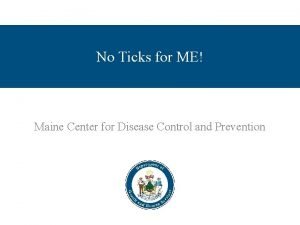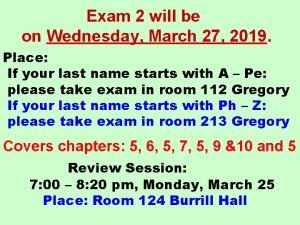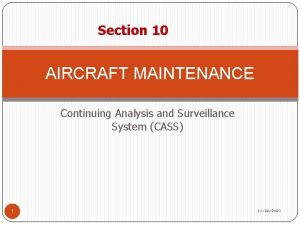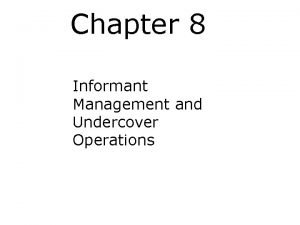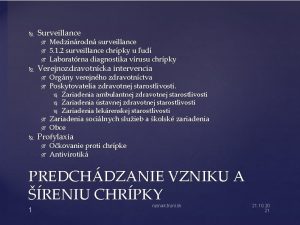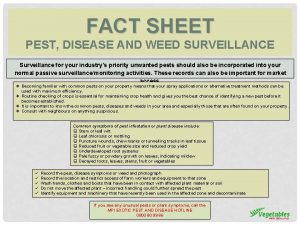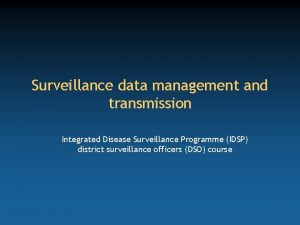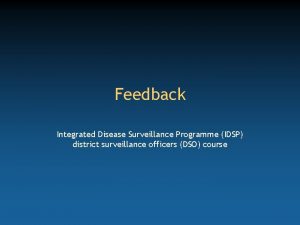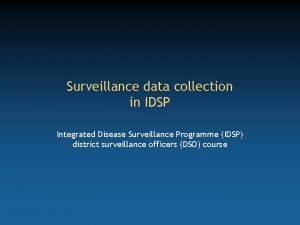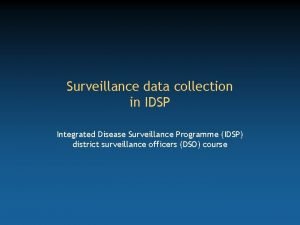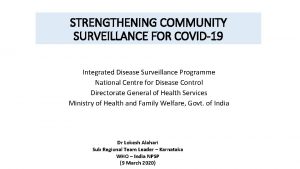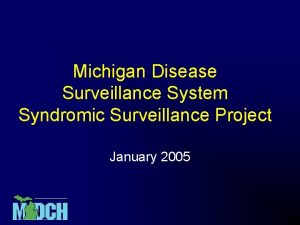Leadership communication surveillance disease control and mass care






















- Slides: 22

Leadership, communication, surveillance, disease control, and mass care: validity and reliability of a self-assessment tool. Savoia E, Testa MA, Biddinger P, Cadigan R, Campbell P, Koh H, Stoto MA. 135 th APHA Meeting – November 2007 - Washington DC 2007

Introduction Policy makers need to know if recent investments have improved public health system preparedness n Most preparedness measures lack evidence of validity and reliability n Study aim: test the reliability and validity of a tool for assessing preparedness capabilities during tabletop exercises n ¨ First n such study in public health preparedness Conceptual framework derived from the logic model developed by RAND

Preparedness logic model n Goal: “To prevent, protect against, quickly respond to, and recover from health emergencies, particularly those whose scale, timing or unpredictability threatens to overwhelm routine capabilities” n Objectives ¨ Earliest possible detection and characterization of a disease outbreak or bioterrorist attack ¨ Early and effective response including n Treat cases n Prevent spread n Minimize psychological and social consequences n Minimize infrastructure and environmental harm ¨ Earliest possible recovery and return to normal

Pandemic Flu Functional Capabilities n n Surveillance and epidemiology (assessment) Disease control and prevention (policy development) Mass care (assurance) Communication within the “public health system” ¨ with the public ¨ n Leadership and management

Conceptual framework Using the above mentioned logic model through a Modified Delphi Technique, we convened a panel of 10 experts in emergency preparedness to identify those public health functional capabilities that could be reasonably tested during a tabletop exercise. The panel vetted 5 domains and 42 indicators: 1. Surveillance and epidemiology (6 indicators) 2. Disease control and prevention (8 indicators) 3. Mass care (9 indicators) 4. Leadership (11 indicators) 5. Communication (8 indicators) 5 a within the public health system 5 b with the public

Study population The study population comprised 179 public officials who attended 3 tabletop exercises in Massachusetts and Maine between September 2005 and November 2006. In advance of each exercise, participants were grouped into tables based on geography, such that all responders from the same or neighboring communities were seated together. In addition for one of the 3 exercises we recruited 12 external evaluators who judged the community performance using the same measurement tool given to participants.

Exercise scenario n Announcement of the first human case of Avian Influenza Type A (H 5 N 1) in the U. S. , resulting in widespread infection throughout the state. n The scenario spanned a timeline of 14 days n The exercise was designed to test a range of local and regional capabilities, including: unified command, regional coordination, inter- and intra-agency communications, riskcommunication to the public, infection control, surge capacity, and mass care.

Statistical Method n Internal consistency of multi-item scales was calculated by means of Cronbach’s alpha. n Correlations were determined by Pearson’s product moment coefficient. n The empirical structure of the scales was determined by principal components analysis (PCA).

Criterion validity: the role of external observers n For one of the 3 exercises we recruited 12 experts in emergency preparedness knowledgeable of the plans tested n They were trained prior to the event n They used the same questionnaire given to participants n Their responses were correlated to those given by participants using ICC coefficients.

Results: Internal Consistency All scale alpha coefficients were. 81 or higher: n n n Leadership and management (0. 93) Mass care (0. 88) Communication within the public health system (0. 86) Disease control and prevention (0. 87) Surveillance and epidemiology (0. 81).

Results: Factor Analysis (participants) n The 42 item questionnaire was subjected to a principal components analysis. n A five–factor solution (which accounted for 60% of the total variance) was found to be parsimonious, had good simple structure, and could be meaningfully interpreted. n Items with factor loadings greater than 0. 45 were used to define the factors, of the original 42 items 37 met the criteria.

Leadership and Management Factor loading Q 1. Identify activities that will be performed at a state, local or coordinated level 0. 63 Q 2. Interact with local, state and federal officials with regard to the delegation of legal and law enforcement responsibilities. 0. 54 Q 3. Identify the authority for declaring a public health emergency 0. 54 Q 4. Gather resources in support of implementing action 0. 71 Q 5. Assess and manage local resources 0. 73 Q 6. Address and respond to cross-jurisdictional needs 0. 64 Q 7. assist special needs populations 0. 62 Q 8. Respond flexibly, in proportion to the magnitude and severity of the scenario and available resources 0. 78 Q 9. Activate psychosocial needs and activate appropriate services 0. 66 Q 10. Activate community based organizations in the response 0. 61 Q 11. Communicate with the general public about up to date outbreak information, disease control requirements, individual risk reduction, when and where to seek medical care. 0. 52

Mass care Factor loading Q 12. Ensure continuity of operations 0. 67 Q 13. Assure health care for all cases that meets relevant standard of care 0. 70 Q 14. Protect healthcare workers with personal protective equipment( PPE) and infection control practices. 0. 71 Q 15. Activate and use the strategic National Stockpile 0. 57 Q 16. Prioritize the sue of limited medical supplies 0. 59 Q 17. Provide security within health cared facilities and mass point of dispensing( POD) sights 0. 57 Q 18. Coordinate medical reserve Corps 0. 45 Q 19. Provisions of mortuary services 0. 63

Communication within the public health system Factor loading Q 20. Provide current information (i. e. newly hospitalized cases, newly quarantined cases) to policy makers. 0. 67 Q 21. Disseminate infection control policies to hospitals and healthcare providers. 0. 65 Q 22. Communicate with public health agencies in neighboring communities and state. 0. 67 Q 23. Communicate within the local public healthcare system ( including other government agencies). 0. 68

Disease control and prevention Factor loading Q 24. Knowledge of the legal authorities regarding isolation and quarantines. 0. 50 Q 25. Availability of procedures to manage isolation and quarantines. 0. 55 Q 26. Capacity to support people in quarantine (i. e. pre-identified sites, support for home quarantine. 0. 56 Q 27. Implement community interventions such as school closing. 0. 48 Q 28. Conduct mass screening. 0. 54 Q 29. Distribute limited medical supplies( including vaccines) to priority groups. 0. 57 Q 30. Control population movement in and out of the community. 0. 61 Q. 31 Communicate with the pubic to minimize fear. 0. 58

Surveillance and Epidemiology Factor loading Q 32. Receive and respond to urgent case reports 0. 54 Q 33. Investigate and track reported cases. 0. 73 Q 34. Track information (i. e. newly hospitalized cases, newly quarantined cases) for policy makers. 0. 81 Q 35. Laboratory capacity (i. e. rapid identification of unusual influenza strains), including the ability to ship specimens to state or CDC lab. 0. 65 Q 36. Link with and share date among different surveillance systems (e. g. sate DOH, CDC, other communities, states and local hospitals etc. ) 0. 66 Q 37. Step up surveillance capacity in time to initiate containment protocols. 0. 63

Domains structure The five dimensions were positively and significantly correlated to each others. Large correlations between: n Leadership and mass care (Pearson 0. 67, p-value<0. 001), n Leadership and disease control (Pearson 0. 68, p-value<0. 001) n Leadership and communication within Public Health (Pearson 0. 66, p-value<0. 001) n Surveillance and disease control (Pearson 0. 45, p<0. 001) Weak correlations between: n Leadership and surveillance (Pearson 0. 33, p-value<0. 001). n Surveillance vs other than disease control

Results: criterion related validity n For the purpose of this study we assumed that the expert’s assessments qualify as the “gold standard”. n We calculated inter-rater agreement and consider it as expression of measurement reliability as well as indicator of criterion-related validity. n The level of agreement ranged from good to excellent depending on the scale: communication within public health (ICC=0. 91), disease control and prevention (ICC=0. 89), surveillance and epidemiology (ICC=0. 72), mass care (ICC=0. 67) and leadership and management (ICC=0. 56). n The scores given by the external evaluators resulted to be overall lower than those given by the external evaluators


Conclusion We developed a measurement tool to be used by participants and external evaluators during training activities, such as tabletop exercises, to identify preparedness areas in need of further improvement at the public health system level. The methodology can be replicated by others using different assessment tools. The instrument: n Consists of 37 -items n Is Reliable n With preliminary evidence of construct and criterion related validity

Limitations Accountability vs training n Trained vs untrained external evaluators n Level of preparedness of respondents (high number of missing values in rural areas) n

n Thanks ! Dr Elena Savoia – HSPH CPHP esavoia@hsph. harvard. edu
 Communicable disease and non communicable disease
Communicable disease and non communicable disease Strategic control process
Strategic control process Levels of health care primary secondary tertiary
Levels of health care primary secondary tertiary Transformational leader and transactional leader
Transformational leader and transactional leader Chapter 26 infectious disease prevention and control
Chapter 26 infectious disease prevention and control European centre for disease prevention and control
European centre for disease prevention and control Society for disease control and research
Society for disease control and research Pest and disease control
Pest and disease control Sugarcane disease and control
Sugarcane disease and control Is atomic mass and relative atomic mass the same
Is atomic mass and relative atomic mass the same Difference between atomic mass and atomic number
Difference between atomic mass and atomic number Atomic weight of oxygen
Atomic weight of oxygen Atomic mass and mass number
Atomic mass and mass number Adaptive leadership characteristics
Adaptive leadership characteristics Situational leadership vs adaptive leadership
Situational leadership vs adaptive leadership The disease-control phase of treatment includes
The disease-control phase of treatment includes Disease control
Disease control Disease control
Disease control Center for disease control
Center for disease control Center for disease control
Center for disease control Continuous analysis and surveillance system
Continuous analysis and surveillance system Prc-137 hf radio
Prc-137 hf radio Informant management
Informant management





